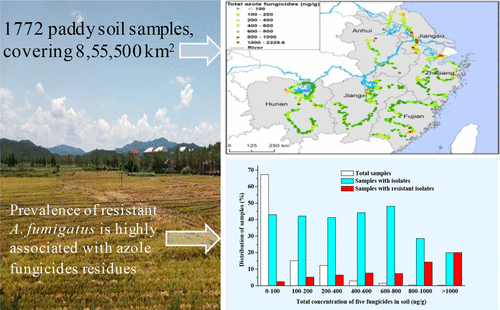当前位置:
X-MOL 学术
›
Environ. Sci. Technol.
›
论文详情
Our official English website, www.x-mol.net, welcomes your
feedback! (Note: you will need to create a separate account there.)
Prevalence of Azole-Resistant Aspergillus fumigatus is Highly Associated with Azole Fungicide Residues in the Fields
Environmental Science & Technology ( IF 10.8 ) Pub Date : 2021-02-05 , DOI: 10.1021/acs.est.0c03958 Duantao Cao , Feiyan Wang , Sumei Yu , Suxia Dong , Ruilin Wu , Ning Cui , Jingbei Ren , Tianheng Xu , Saige Wang , Mengcen Wang , Hua Fang , Yunlong Yu
Environmental Science & Technology ( IF 10.8 ) Pub Date : 2021-02-05 , DOI: 10.1021/acs.est.0c03958 Duantao Cao , Feiyan Wang , Sumei Yu , Suxia Dong , Ruilin Wu , Ning Cui , Jingbei Ren , Tianheng Xu , Saige Wang , Mengcen Wang , Hua Fang , Yunlong Yu

|
Triazole resistance in Aspergillus fumigatus is a growing public health concern. In addition to its emergence in the therapy of invasive aspergillosis by triazole medicines, it has been frequently detected in agricultural fields all over the world. Here, we explore the potential link between residues of azole fungicides with similar chemical structure to triazole medicines in soil and the emergence of resistant A. fumigatus (RAF) through 855 500 km2 monitoring survey in Eastern China covering 6 provinces. In total, 67.3%, 15.2%, 12.3%, 2.9%, 1.5%, 0.4%, and 0.3% of the soil samples contained these five fungicides (tebuconazole, difenoconazole, propiconazole, hexaconazole, and prochloraz) of 0–100, 100–200, 200–400, 400–600, 600–800, 800–1000, and >1000 ng/g, respectively. The fractions of samples containing RAF isolates were 2.4%, 5.2%, 6.4%, 7.7%, 7.4%, 14.3%, and 20.0% of the samples with total azole fungicide residues of 0–100, 100–200, 200–400, 400–600, 600–800, 800–1000, and >1000 ng/g, respectively. We find that the prevalence of RAFs is positively (P < 0.0001) correlated with residual levels of azole fungicides in soils. Our results suggest that the use of azole fungicides in agriculture should be minimized and the intervals between treatments expanded to reduce the selective pressure toward the development of resistance in A. fumigatus in agricultural fields.
中文翻译:

耐偶氮菌的烟曲霉的发病率与田间杀唑剂的残留高度相关
烟曲霉对三唑的抗药性日益引起人们的公共卫生关注。除了它在三唑类药物治疗侵袭性曲霉病中的出现外,它在世界各地的农业领域也经常被发现。在这里,我们探讨了在土壤中与三唑类药物具有相似化学结构的唑类杀真菌剂残留与通过855 500 km 2出现的耐烟曲霉(RAF)之间的潜在联系。东部地区6个省的监测调查。总共有67.3%,15.2%,12.3%,2.9%,1.5%,0.4%和0.3%的土壤样品含有这5种杀菌剂(戊唑醇,二苯并呋喃唑,丙环唑,六环唑和丙氯唑),分别为0-100、100分别为–200、200–400、400–600、600–800、800–1000和> 1000 ng / g。含有RAF分离物的样品所占比例为2.4%,5.2%,6.4%,7.7%,7.4%,14.3%和20.0%,其中唑类杀真菌剂的总残留量为0-100、100-200、200-400,分别为400–600、600–800、800–1000和> 1000 ng / g。我们发现英国皇家空军的患病率是正的(P<0.0001)与土壤中唑类杀真菌剂的残留水平相关。我们的研究结果表明,应尽量减少在农业中使用唑类杀菌剂,并延长处理间隔,以减少对农田烟曲霉产生抗性的选择性压力。
更新日期:2021-03-02
中文翻译:

耐偶氮菌的烟曲霉的发病率与田间杀唑剂的残留高度相关
烟曲霉对三唑的抗药性日益引起人们的公共卫生关注。除了它在三唑类药物治疗侵袭性曲霉病中的出现外,它在世界各地的农业领域也经常被发现。在这里,我们探讨了在土壤中与三唑类药物具有相似化学结构的唑类杀真菌剂残留与通过855 500 km 2出现的耐烟曲霉(RAF)之间的潜在联系。东部地区6个省的监测调查。总共有67.3%,15.2%,12.3%,2.9%,1.5%,0.4%和0.3%的土壤样品含有这5种杀菌剂(戊唑醇,二苯并呋喃唑,丙环唑,六环唑和丙氯唑),分别为0-100、100分别为–200、200–400、400–600、600–800、800–1000和> 1000 ng / g。含有RAF分离物的样品所占比例为2.4%,5.2%,6.4%,7.7%,7.4%,14.3%和20.0%,其中唑类杀真菌剂的总残留量为0-100、100-200、200-400,分别为400–600、600–800、800–1000和> 1000 ng / g。我们发现英国皇家空军的患病率是正的(P<0.0001)与土壤中唑类杀真菌剂的残留水平相关。我们的研究结果表明,应尽量减少在农业中使用唑类杀菌剂,并延长处理间隔,以减少对农田烟曲霉产生抗性的选择性压力。











































 京公网安备 11010802027423号
京公网安备 11010802027423号